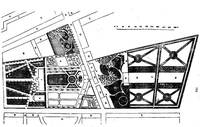441. The botanic garden of the university of Lund (fig. 134.) was founded in the first half of the eighteenth century. Its professors and directors have been Andrew Lidbeck, A. J. Retzius, and the distinguished C. A. Agardh. The gardener in 1826 was O. J. N. Morch, but in 1833 it was M. Lundbuz. The garden contains about two and a half English acres; the soil is a mixture of gravelly clay and mould; and the surface is somewhat irregular. It has been remarked that the box tree thrives here remarkably well, there being hedges of that shrub upwards of six feet high. The tender plants are said to thrive here better than in the garden at Copenhagen. The herbaceous plants are arranged according to Professor Agardh's Aphorismi Plantarum; each genus being planted by itself. There are a good many species of trees and shrubs, though but few North American plants. The greenhouses contain the plants of the South of Europe; but few natives of the Cape, or of New Holland. The most remarkable plants in the stoves are the banana and the date. The hothouses are heated by German stoves, in which wood is burned as fuel. The garden has no library, herbarium, or collection of seeds; nor is this to be wondered at, when it is considered that the entire expense of the establishment, including the gardener's salary, seldom exceeds 50l. a year. The total number of species in this garden, in 1829, was 2300. An arboretum was planted by M. Morch, and also a shrubbery in the English style. A good many white mulberry trees had been propagated, with a view to the culture of the silkworm; but the severe winter of 1798 destroyed most of the trees, and the culture has been given up. The worms were reared in the orangery in the botanic garden; some silk cloth was made, and a fragment is still kept in the museum at Lund, of a piece which was presented to the queen. No attempt was made to renew this plantation, which is now occupied by trees of the A'cer Pseudo-Platanus, introduced into Sweden from Holland, in the year 1770. The following are details of the plan: � A, The botanic garden. B, The new arboretum. C, The plantation. 1, Old academy. 2, New academy. 3, The astronomical observatory. 4, Vestibule to the academy. 5, Anatomical theatre over the same. 6, Conservatory. 7, Stove. 8, Gardener's house. 9, Conservatory. 10, Conservatory. 11, Store. 12, Lecture-room. 13, Arrangements of herbaceous plants according to the natural system. 14, Arrangement of trees and shrubs. 15, Annual plants. 16, New arboretum. 17, Medicinal plants. 18, Rockwork or lapidarium. 19, Old infirmary. 20, New infirmary. 21, Lying-in hospital. 22, Storehouse and kitchen for the lying-in hospital. 23, Place of exercise for invalids. 24, Garden of medicinal herbs for the hospital. 25, Area for gymnastic exercises. 26, Campus experimentalis (field for trying experiments). 27, Seminarium (seed place). 28, Pinetum (various species of pines). 29, Acerinum (various species of acers). 30, Fruticetum (a collection of fruit trees). 31, Hedge of box, 6 feet broad at the base, and 6 feet high.

